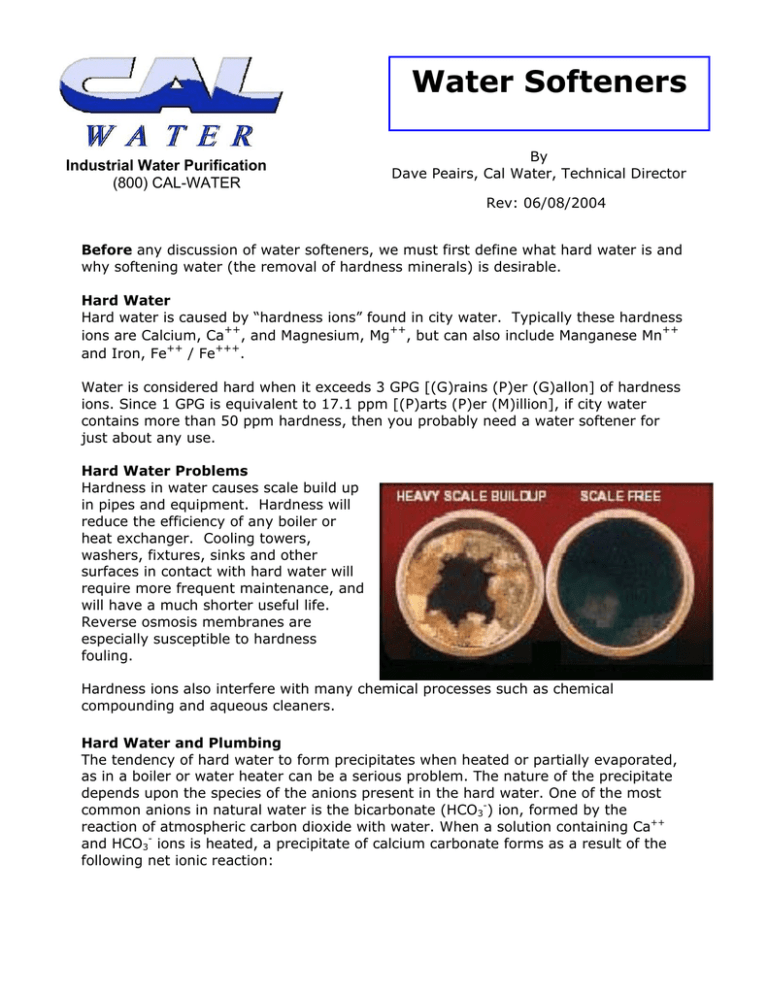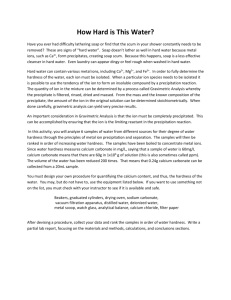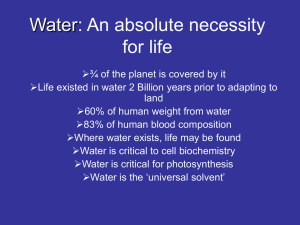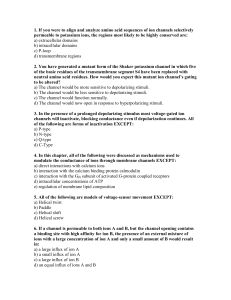Water Softeners Industrial Water Purification (800) CAL-WATER
advertisement

Water Softeners Industrial Water Purification (800) CAL-WATER By Dave Peairs, Cal Water, Technical Director Rev: 06/08/2004 Before any discussion of water softeners, we must first define what hard water is and why softening water (the removal of hardness minerals) is desirable. Hard Water Hard water is caused by “hardness ions” found in city water. Typically these hardness ++ ++ ++ ions are Calcium, Ca , and Magnesium, Mg , but can also include Manganese Mn ++ +++ / Fe . and Iron, Fe Water is considered hard when it exceeds 3 GPG [(G)rains (P)er (G)allon] of hardness ions. Since 1 GPG is equivalent to 17.1 ppm [(P)arts (P)er (M)illion], if city water contains more than 50 ppm hardness, then you probably need a water softener for just about any use. Hard Water Problems Hardness in water causes scale build up in pipes and equipment. Hardness will reduce the efficiency of any boiler or heat exchanger. Cooling towers, washers, fixtures, sinks and other surfaces in contact with hard water will require more frequent maintenance, and will have a much shorter useful life. Reverse osmosis membranes are especially susceptible to hardness fouling. Hardness ions also interfere with many chemical processes such as chemical compounding and aqueous cleaners. Hard Water and Plumbing The tendency of hard water to form precipitates when heated or partially evaporated, as in a boiler or water heater can be a serious problem. The nature of the precipitate depends upon the species of the anions present in the hard water. One of the most common anions in natural water is the bicarbonate (HCO3-) ion, formed by the reaction of atmospheric carbon dioxide with water. When a solution containing Ca++ and HCO3- ions is heated, a precipitate of calcium carbonate forms as a result of the following net ionic reaction: - = 2 HCO3 + heat CO3 + CO2 (gas) + H2O The carbonate then reacts with calcium Ca Ca ++ ++ + CO3 = + 2HCO3- CaCO3 (solid) CaCO3 (solid) + CO2 (gas) + H2O Boilers and Hot Water Systems Hard water causes pipes to scale up. Scale collects on heating elements, shortening their life and making them operate less efficiently. Hard water also contributes to inefficient and costly operation of water-using equipment. Heated hard water forms a scale of calcium and magnesium salts. Pipes can become clogged with scale that reduces water flow and ultimately requires pipe replacement. Thickness of Scale in inches Percentage Loss of Thermal Efficiency 1/16 .....…............... 15% 1/8 ................…..... 25% 1/4 ....................... 39% 3/8 .........................55% 1/2 ........................ 70% Reverse Osmosis membranes Reverse osmosis works by passing a feed water across the membrane, allowing a substantial fraction of the water to pass through the membrane, leaving the concentrated contaminants behind. As pure water is removed, the contaminants build up in concentration. As soon as that concentration exceeds the solubility of a particular species, precipitation can occur resulting in scaling. Ca ++ (aq.con.) + CO3 = CaCO3 (solid) Because of the low solubility of hardness ions, saturation of those ions is exceeded at even a modest recovery rate, causing scale formation. Scaling reduces the efficiency of the membrane by reducing the effective surface area by both crystallization and the tendency to co-precipitate other ions and insoluble particles, and by being a source of contaminants. Once hardness scale has formed on a membrane, it is difficult to remove during a cleaning, again because of the low solubility of hardness ions. Even after cleaning, sub-microscopic scale deposits on the membrane surface can provide nucleation sites for the formation of new scale with the attendant co-precipitates. Laundering Problems Hardness minerals combine with some soils to form insoluble salts, making them difficult to remove from cloth. Continuous laundering of cloth in hard water can damage fibers and shorten the life of fabrics by up to 40 percent. Hard water used to make up cleaning solutions reduces the efficiency of the alkaline cleaners so that more cleaner is required. The use of extra cleaners results in a larger amount of chemical being released to the environment. Removing hardness and other salts from process water reduces chemical and maintenance costs. It will also improve the quality control and minimize the environmental impact of processes. Reactions - How Soap Scum is Formed Hard water has many undesirable tendencies, one of which is to form a precipitate with the most common type of soap which contains sodium stearate, NaC18H35O2, the sodium salt of an organic acid. The calcium and magnesium salts of this acid are insoluble in water. And example of this reaction is: Ca ++ + 2C18H35O2 - Ca(C18H35O2)2 (solid) ++ ++ This reaction continues until nearly all the Ca or Mg ions are removed from the water by forming the soap scum precipitate; only then does soap become effective as a cleansing agent. Water Softeners Types of Water Softeners Water softeners are not all equal. There are essentially two kinds of water softeners: 1) Those that work and, 2) those that don’t work. Softeners that work include the standard ion exchange water softeners known and used world wide, hot or cold lime softening, and eventually new divalent rejector RO membranes, and some ED (Electro-Dialysis) softening processes. “Softeners” that don’t work, (at least reliably) are anything magnetic or electromagnetic. Standard Ion Exchange Water Softeners The type of Water softener that will work on all city water chemistry, the type that works the world over, is the type that operates on the ion exchange principle. When you really need soft water, the only answer today is an ion exchange water softener. (Someday RO and/or ED may be legitimate economic alternatives.) The Ion Exchange Softening Process In the ion exchange water softening process, water is passed through a bed of sulfonated styrene-divynalbenzene spherical resin beads (about 1 mm in diameter). The exchange sites created on the beads by the sulfonation process are then saturated with sodium ions by passing a brine solution through the resin. The ion ++ ++ exchange “softening” process takes place when the hardness ions, Ca and Mg attach themselves to the resin beads causing the sodium ions on the resin beads to be released into the water. Using an Ion Exchange Column (R = Ion Exchange Resin Site) Ca ++ (aq) + Na2R(solid) + CaR(solid) + 2Na (aq) When the resin becomes saturated with calcium and magnesium, it is regenerated by passing an NaCl brine solution through the resin. The high concentration of sodium ions in the brine causes the reaction to be reversed with sodium replacing the calcium and magnesium ions which are then discharged into the waste water. + 2Na + (aq.con.) + CaR (solid) Na2R (solid) + Ca ++ (aq) All true water softeners work on this principal. This type of scale can be prevented by an ion exchange water softener, or by a = dealkalizer. A dealklizer is an anion exchanger which removes the carbonate CO3 component, thus preventing a calcium or magnesium carbonate scale from forming. Unfortunately more serious problems arise if significant quantities of sulfate ion are present in the hard water (as they usually are). In this case, heating may produce a precipitate of calcium sulfate, which, curiously enough, is less soluble at high than at low temperatures: ++ = (aq) + SO4 (aq) CaSO4 (solid) Ca Crystals of calcium sulfate are particularly likely to form in a steam boiler in which ++ water is constantly being vaporized, thereby increasing the concentrations of Ca = and SO4 ions. The calcium sulfate deposits as a hard, almost insoluble scale, which lowers the heat conductivity of the boiler. Eventually, the deposition of calcium sulfate in boiler tubes may block the flow of water and lead to rupture of the pipes. The surest way to prevent any type of hardness scale buildup is with an ion exchange ++ ++ water softener whose objective is the removal of Ca and Mg ions. Ca ++ (aq) + Na2R (solid) + CaR (solid) + 2 Na (aq) “R” again represents the ion exchange resin. The net effect of this process is the ++ ++ replacement of Ca and Mg ions responsible for hardness with unobjectionable + Na ions. Other cations, especially those with a greater ion exchange affinity, such as the dissolved cations of radium, barium, lead, strontium, copper, zinc, and iron will also be removed from the water in the ion-exchange water softening process. In the ++ ++ ion exchange process there is no precipitate to filter off since the Ca , Mg , and all other multi-valent cations are selectively removed by the resin. Because of the equilibrium relationship for the ion exchange reaction it is ordinarily necessary to pass water through a column a few feet long or deep to achieve a ++ ++ + complete quantitative replacement of Ca and Mg ions by Na ions. Added Sodium Hard water treated with a standard ion exchange water softener has sodium added. According to the Water Quality Association (WQA), the ion exchange softening process adds sodium at the rate of about 8 mg/liter for each grain of hardness removed per gallon of water. One milligram is the equivalent of several grains of table salt. The ion exchange method of water softening is applicable to large or small-scale operations; ion exchangers can be used to treat the water supply of a home, a factory, or an entire city. Lime-Soda Softening (Hot and Cold) A lime-soda method of water softening, once used extensively before the advent of high capacity softening ion exchange resin, has gradually lost favor because of its many economic disadvantages. Before treatment by the lime-soda method the water + must be analyzed for Ca2 and HCO3 ions; the amounts of lime and soda added must be carefully controlled, and the calcium carbonate formed must be removed from the water by filtration or settling. All of these processes are time-consuming and expensive. Divalent Rejector RO Membranes, and ED Softening Processes Both RO and/or ED technology as water softeners show great promise as water softeners of the future. At present both technologies are quite expensive for softening and usually produce an unacceptable amount of wastewater. But progress is being made in both technologies. Magnetic “Water Softeners” A lot of study has gone into the principles and function of magnetic “Water Softeners” in the United States and around the world. The results have been mixed. The tests run of the function of these devices by the device manufacturers usually turn out fine, while tests run by anybody else usually don’t. Although a variety of claims are made about electronic/magnetic devices softening water, through “Pre-precipitation”, changing the hardness in the water from “Sticky” crystals to “Non-sticky”, or somehow rendering the hardness ions inert; the applications of these devices are at best limited to very specific feed water chemistry. In the tests that I have run personally, the magnetic “water softener” did exactly nothing. (I must have had the wrong feed water chemistry.) Bibliography and reading list, available upon request. Industrial Water Purification (800) CAL-WATER




